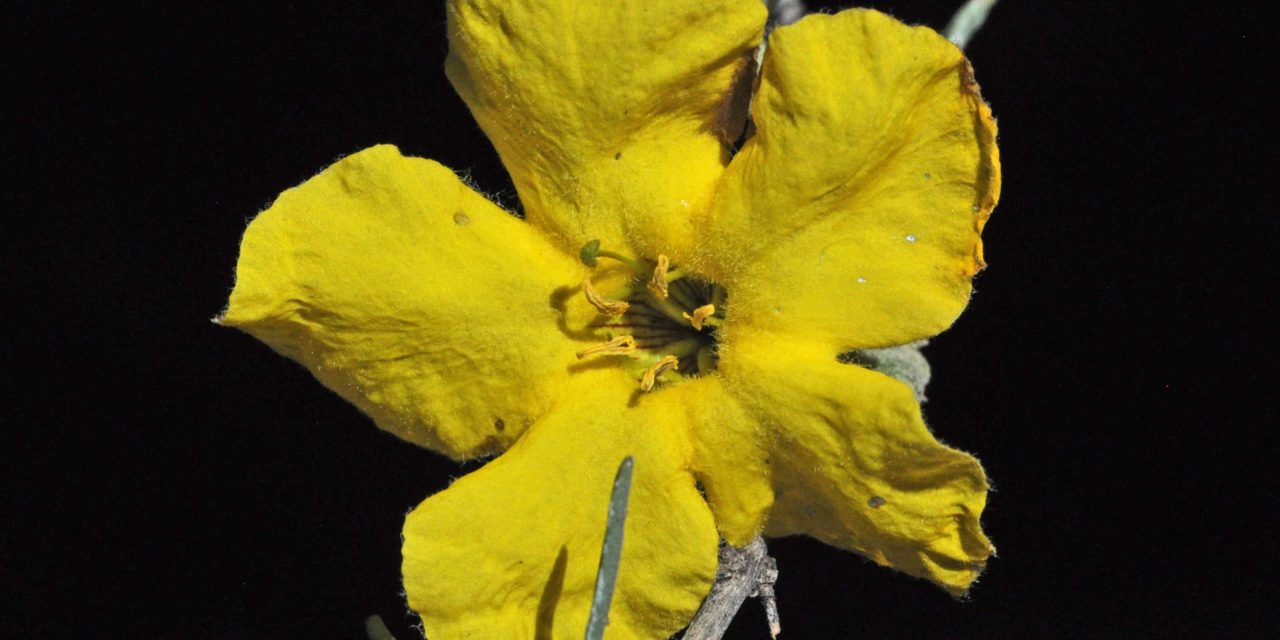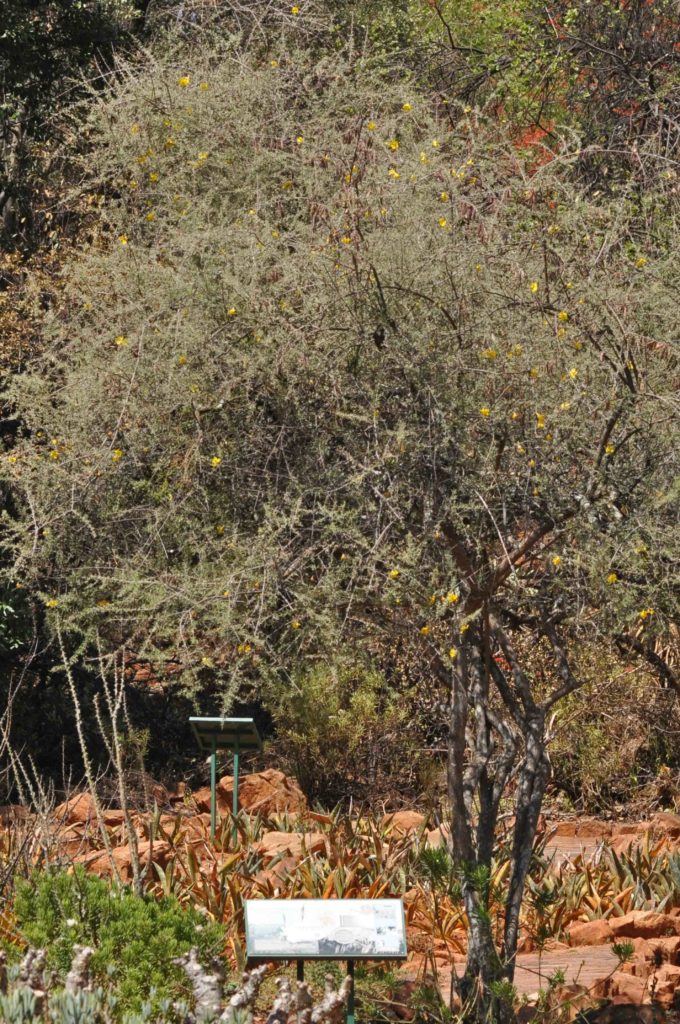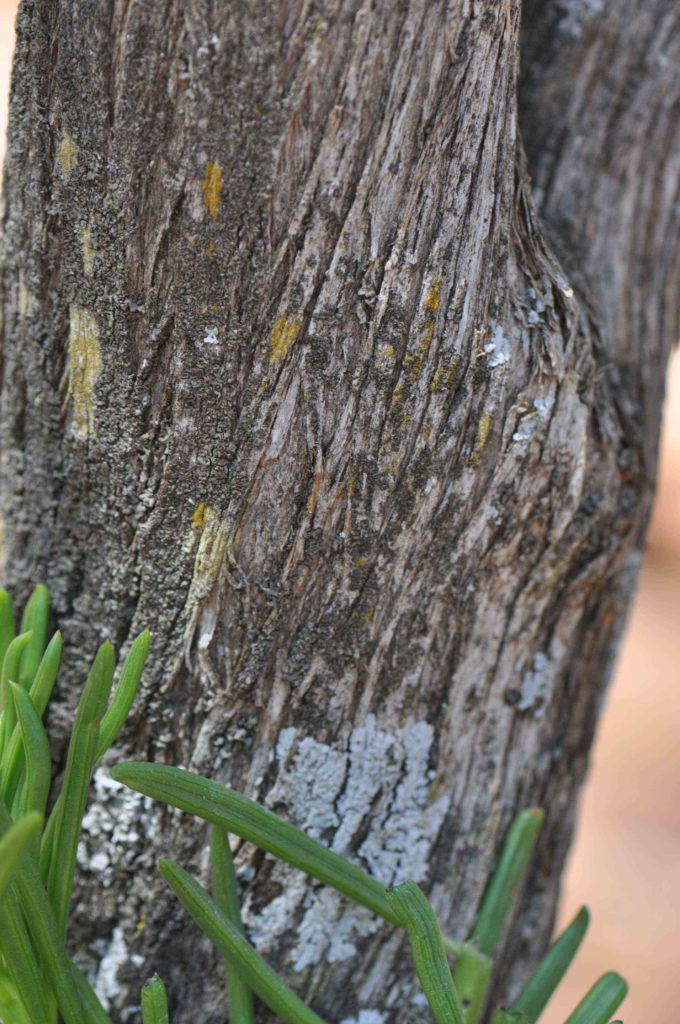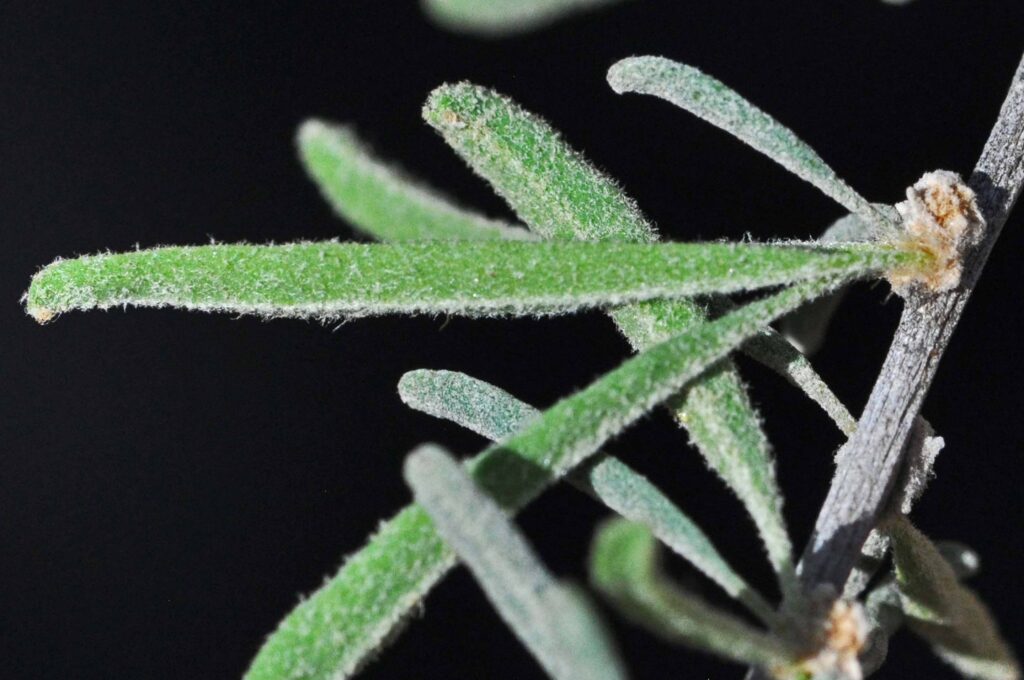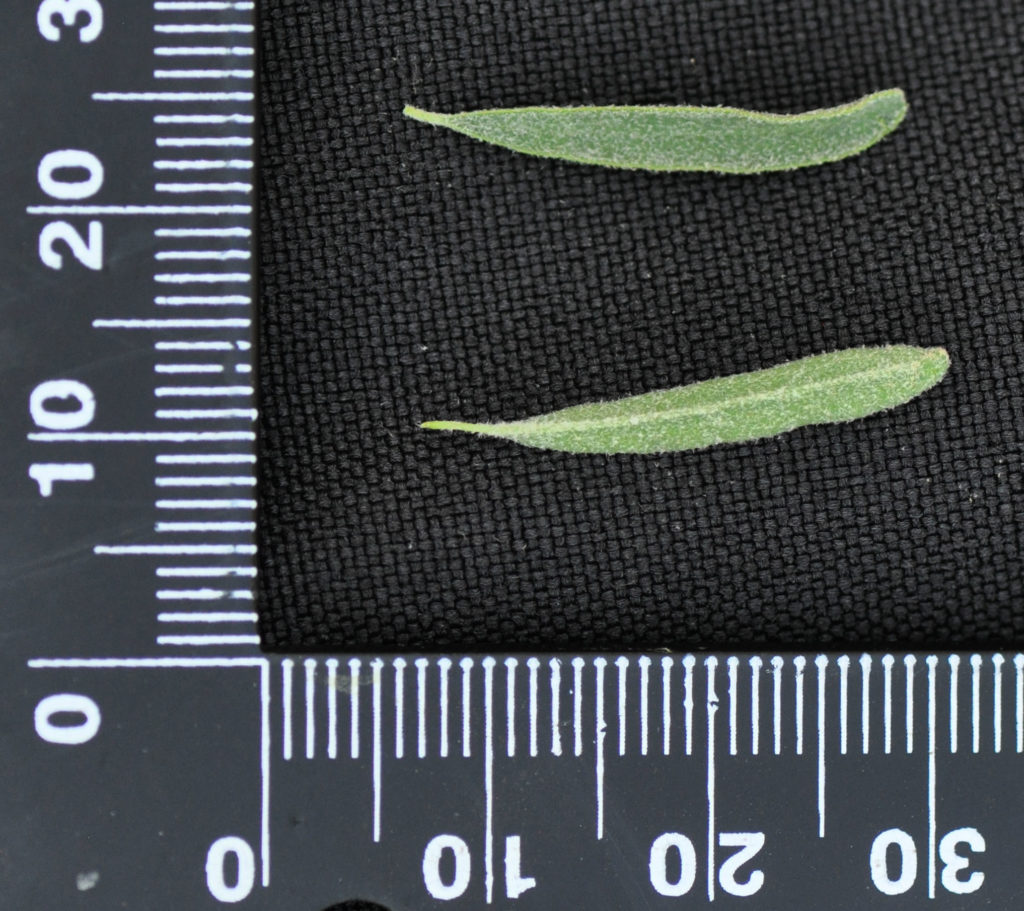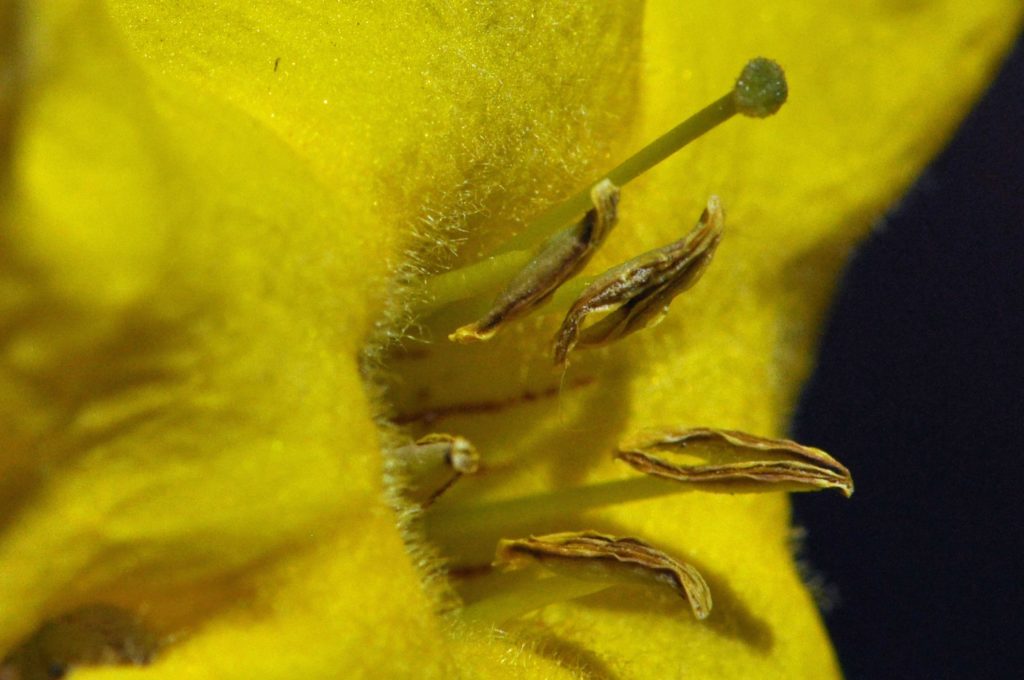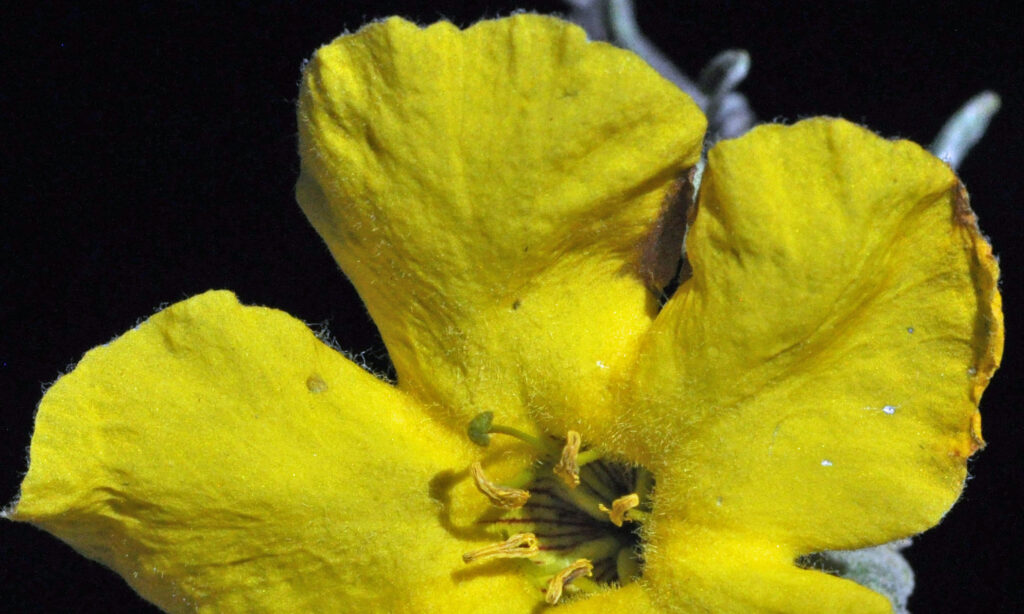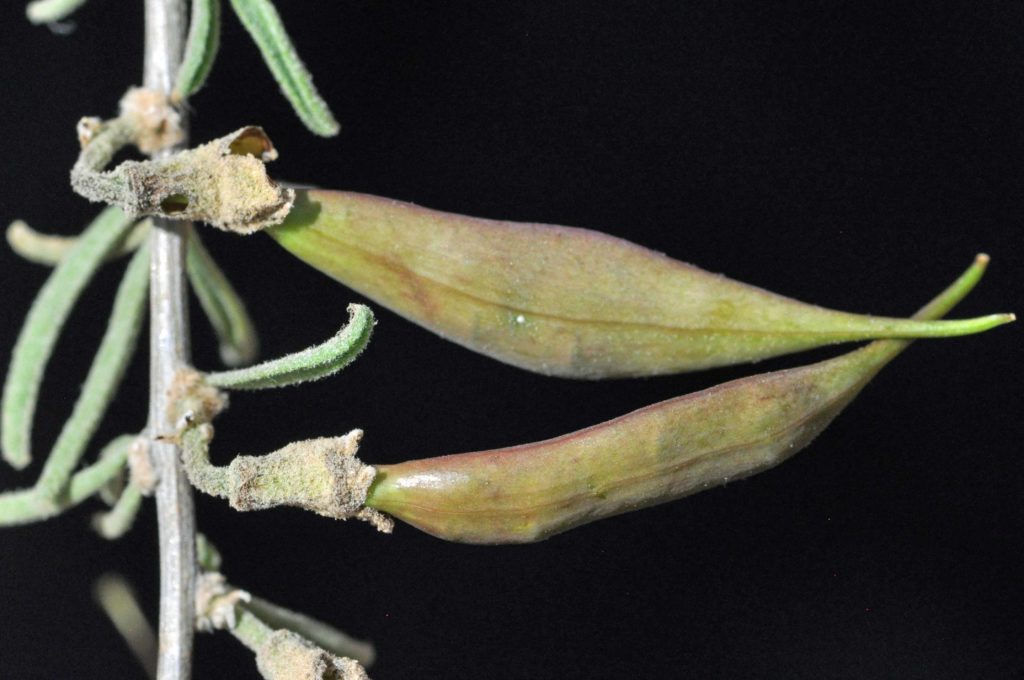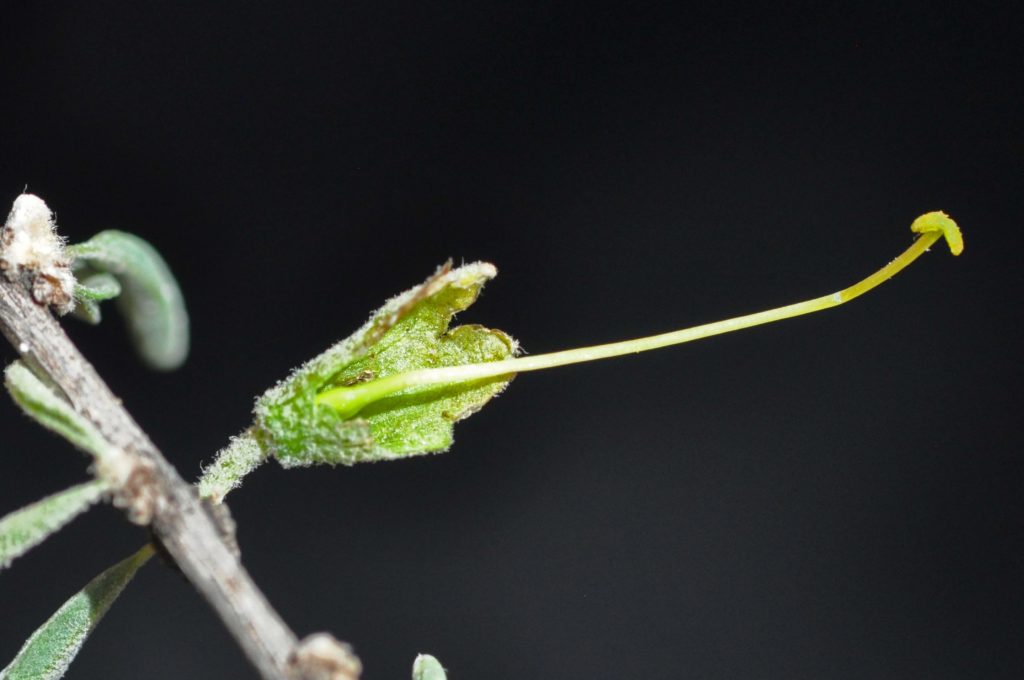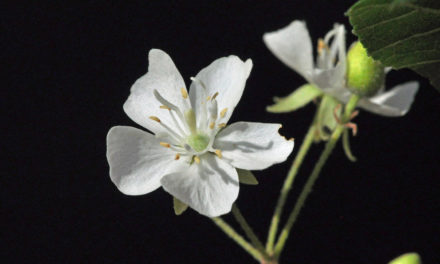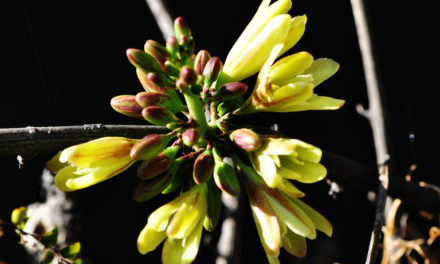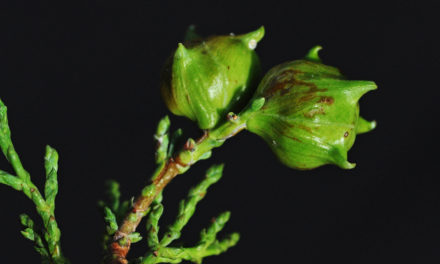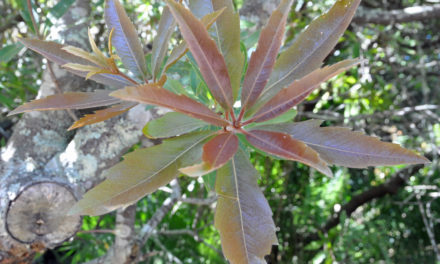General Info – summary
This multi-stemmed shrub may also be a small Tree up to 4m high. Leathery, hairy and narrow deciduous Leaves are usually simple with entire margins. Bisexual 5-merous Flowers are up to 4cm wide. Attractive, yellow horizontal petal lobes have slightly extending stamens. The green/brown Fruit is a capsule with a persistent calyx. Here the petals have fallen. The light brown seeds have papery wings.
Description
Rhigozum brevispinosum
Previous Names: Rhigozum binifolium, Rhigozum linifolium, Rhigozum spinosum.
SA Tree No. 674
Common names: (Afr) Kortdoringgranaat. (Eng) Simple-leaved Rhigozum, Short-thorn Pomegranate. (Setswana) Mohurukwana.
Family: Bignoniaceae (Jacaranda family). There are about 104 genera and 810+ species. In the RSA, there are 6 genera + 2 naturalised with a total of 13 species. The indigenous genera with trees on this website include Bignonia, Kigelia, Markhamia, Rhigozum, and Tecomaria. Most species are woody. Leaves are usually compound, opposite and lack stipules. The usually large and brightly coloured Flowers are bisexual and irregular. They usually occur in panicles or racemes or are solitary. The Calyx has 5 partly united sepals which are shorter than the usually 5 joined Petals producing a conspicuous tube. The petals are often 2-lipped with the upper lip having 3 lobes and the lower lip with 2 lobes. There are usually 4 didynamous Stamens (2 long and 2 short) which arise from the corolla tube. A single staminode may be present. The Anthers have 2 pollen sacs which dehisce longitudinally. There is a superior Ovary with 2 united carpels. Many ovules are present. The simple Style terminates in a Stigma with 2 flattened lobes. The Fruit is usually a bivalved capsule. Seeds are usually flat and usually have a glassy, translucent wing.
Name derivation: Rhigozum – rigid branches. brevispinosum – with short spines. This plant was first collected and named by William John Burchell (1781-1863). He was an English explorer, naturalist artist and author. He spent 4 years travelling in South Africa from 1811. His 7 000km trip was an amazing accomplishment at the time. There are 4 widespread species of Rhigozum in southern Africa.
Conservation Status: L C (Least Concern). Assessed: 2017.09.05 (L. von Staden).
Tree
This plant is a shrub or a small Tree (up to 4m high) that is often multi-stemmed (photo 108). The striated Bark is grey-brown (Photo 88). Short straight Spines (up to 10mm long), developing from short lateral branches are usually present. The many finely striated grey-brown rigid Branches are slender quadrangular and twisted.
- 108 2019.09.27 Pretoria NBG. Photo David Becking.
- 88 2019.09.27 Pretoria NBG. Photo David Becking.
Leaves
The thinly leathery Leaves are slender and oblanceolate (the reverse of lanceolate, the leaf is broader at the apical third than at the middle and tapers towards the base – photo 102). They are slightly lighter green on the lower surface. Leaves are occasionally trifoliate but usually simple (have a single blade which may have incisions that are not deep enough to divide the leaf into leaflets). Each leaf may reach 25 x 4mm (photo 102). The 3-5 leaves initially occur in alternate clusters on woolly cushions (photo 100) and may appear just below the short spines. Margins are entire (with a continuous margin, not in any way indented). Veins are indistinct and leaves are covered with short soft white to grey Hairs (photo 100). Here the Midrib is more visible on the lower side (photo 102). The Apex is rounded or notched. The Base tapers and is decurrent (leaf blades that partly wrap or have wings around the stem or petiole). As a result, the Petiole is short or absent.
- 100. 2019/09/27. Pretoria NBG. Photo David Becking.
- 102 2019.09.27 Pretoria NBG. Photo David Becking.
Flowers
The attractive golden yellow bisexual and 5-merous Flowers are up to 4cm wide. They occur singly (usually) or in pairs. These flowers develop all along the branches sharing cushions with the leaves. The hairy Pedicels (stalks of single flowers) are up to 10mm long (photo 92 – under Fruit). The hairy bell-shaped Calyx is cylindrical near the base and campanulate (bell-shaped) higher up. It ends in 5 lobes. The bright yellow Corolla has spreading, obovate (like an upside-down egg, with the narrower end at the base) Petal Lobes. These lobes are distinctly crinkled around the edges (photo 90). The, up to 2cm long, nearly cylindrical corolla tube, is visibly hairy near the mouth (photo 94). Reddish streaks may be visible in the throat (photo 90). The slightly exerted Stamens (male reproductive part of a flower) which arise from the inside of the tube are slightly exserted. Each Filament (the anther bearing stalk of a stamen) is circular in cross section and hairy at the base. The 5 Anthers eventually produce the pollen grains). The anthers are oblong, up to 5mm long and dehisce longitudinally (photo 94). The ovoid bilocular Ovary contains many ovules. The green terete (circular in cross-section) Style extends slightly beyond the corolla mouth and ends in a capitate (shaped like a head) Stigma (the part that receives the pollen – photo 94). (Sep-Dec).
- 94 2019.09.27 Pretoria NBG. Photo David Becking.
- 90 2019.09.27 Pretoria NBG. Photo David Becking.
Fruit
The smooth, light green to pale brown flattened and thin-walled pod-like Fruit is a compressed beaked Capsule (a dry fruit resulting from the maturing of a compound ovary that usually opens at maturity by one or more lines of dehiscence – photo 104). In this photo, the petals have fallen, and the persistent calyx is visible at the Base. The Apex ends in a sharply pointed tip arising from the style (photo 92). Mature dehiscent capsules are up to 7 x 1,2cm. In order to release seeds, the capsule splits perpendicularly down the centre into 2 loose valves (photo 104). The light brown paper winged Seeds are about 2 x 2cm – including the paper wings. Old brown empty capsules may remain on the plant for months. (Dec-May).
- 104 2019.09.27 Pretoria NBG. Photo David Becking.
- 92 2019.09.27 Pretoria NBG. Photo David Becking. Dissected.
Distribution & Ecology
This plant Occurs in arid bushveld, open woodland and semi desert vegetation. It may occur in rocky areas like the sides of koppies (koppie – a small, natural hill rising up from the flattish African veld) or with limestone outcrops and even in sandy soils. Because the fruits and leaves are edible and located in dry areas, local animals take their toll. The altitude range is 700-1 250m. These trees occur in Northern Cape, Gauteng, North West, Mpumalanga, Limpopo, south-western Zimbabwe, Botswana, Angola, and are widespread in Namibia. Catopsilia florella (African Vagrant or Migrant) is a species of Butterfly whose larvae feed on the leaves of this plant and legumes e.g., Bauhinia galpinii as well as other plants. The males tend to be mainly white and the females mainly white or yellow.
Ethnobotany
The strong Wood is used to make digging sticks instead of spades and they work well. Stock browse this Tree. Some believe that that plant parts have magical uses.
References
Coates Palgrave, M. 2002. Keith Coates Palgrave Trees of Southern Africa, edn 3. Struik, Cape Town.
Palmer, E. & Pitman, N. 1972. Trees of southern Africa. Balkema, Amsterdam, Cape Town.
Schmidt, S. Lotter, M. & McCleland, W. 2002. Trees and Shrubs of Mpumalanga and the Kruger National Park. Jacana, Johannesburg.
van Wyk, B. & van Wyk, P. 1997 Field guide to Trees of Southern Africa, Struik, Cape Town.
von Staden, L. 2017. Rhigozum brevispinosum Kuntze. National Assessment: Red List of South African Plants version 2020.1. Accessed on 2023/11/12.
Woodhall, S. 2020. Field Guide to Butterflies of South Africa, edn 2. Donnelley, RR, China.
https://www.zimbabweflora.co.zw/speciesdata/species.php?species_id=152350
http://www.samj.org.za/index.php/samj/article/view/5093/4021
https://plants.jstor.org/compilation/Rhigozum.brevispinosum
https://lizzieharper.co.uk/2019/02/flower-shapes-terminology/
https://www.madeirabirds.com/african-migrant-catopsilia-florella

